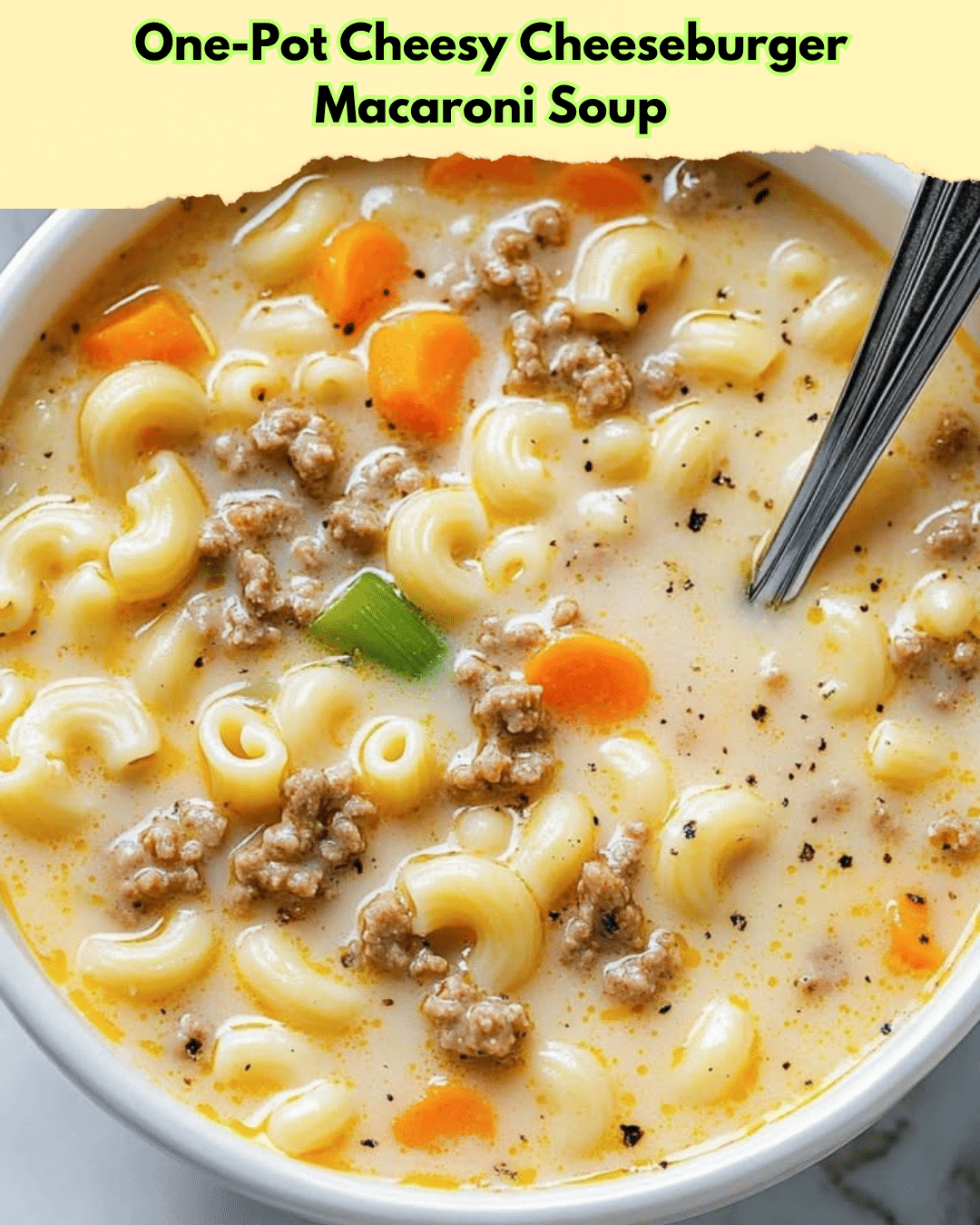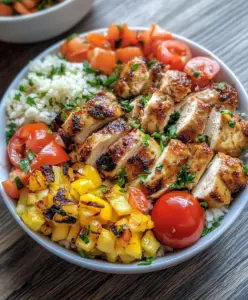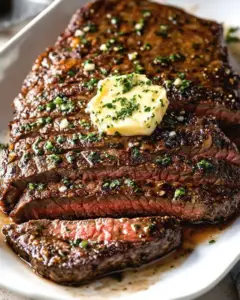One-Pot Cheesy Cheeseburger Macaroni Soup: A Comforting Delight
Warm up your kitchen with the delectable One-Pot Cheesy Cheeseburger Macaroni Soup! This recipe combines the nostalgic flavors of a classic cheeseburger with the irresistible comfort of a creamy soup for a truly satisfying meal. Perfectly cooked pasta, seasoned beef, and a velvety cheesy base come together to create this delightful soup that promises to be a favorite among both adults and kids alike. Imagine cold evenings filled with the rich aroma of melted cheese and savory beef filling your home, making it the perfect dish to snuggle up with by the fire.
Quick and simple, this one-pot wonder is ideal for busy weeknights. With each spoonful, you’ll experience a harmony of textures—from tender morsels of beef to the gooey, cheesy noodles that warm you from the inside out. Prepare to delight your senses with this hearty and rich soup that requires minimal clean-up, allowing you to enjoy more of what matters: time spent sharing smiles and stories over a cherished bowl of this comforting meal.
Quick Recipe Highlights
- Flavor Profile: This soup masterfully blends the flavors of a hearty cheeseburger with the creamy richness of a macaroni and cheese dish.
- Texture: Experience the harmony of tender pasta, crumbly bits of beef, and the smooth, velvety comfort of melted cheese.
- Aroma: The soup fills your home with inviting notes of sautéed onions, browned beef, and creamy cheese, reminiscent of a classic cheeseburger with every sniff.
- Visual Appeal: With its golden hue and flecks of herbs, this soup is as beautiful as it is delicious, ensuring a visually pleasing dish.
- Skill Level Needed: Suitable for all skill levels, this recipe is simple enough for beginners and quick enough for seasoned cooks in a rush.
- Special Equipment: No special equipment is needed—just a reliable pot to bring this cheesy comfort food to life.
Recipe Overview
- Difficulty Level: Simple steps involve browning the beef and combining basic ingredients without any complex techniques, making this meal an easy choice for cooks of any level.
- Category: Ideal as a comforting main course or a hearty lunch option that fills you up and warms your heart.
- Cuisine: A melting pot of American-style comfort food with influences from classic diner cheeseburgers and homey macaroni dishes.
- Cost: Fairly economical with accessible ingredients that fit within most grocery budgets without sacrificing flavor.
- Season: A versatile year-round favorite but finds its peak popularity during the chilly fall and winter months.
- Occasion: Perfect for family dinners, friendly gatherings, and any occasion where warm, comforting dishes are cherished and shared.
Why You’ll Love This Recipe
Taste and texture come together in this lovely soup that never fails to evoke feelings of warmth and happiness. The combination of soft pasta and savory beef enveloped in creamy cheese offers an irresistible balance of flavors that tastes like pure comfort in a bowl. Equally satisfying for adults and children, it’s a dish that welcomes everyone to the table with open arms.
Convenience is key, and this one-pot method ensures a quick and hassle-free cooking experience. With minimal dishes to worry about, you can focus on savoring each spoonful without the dread of a kitchen clean-up to follow. The straightforward preparation process means anyone can whip up this magical dish with ease.
Nutritional advantages include catching a good mix of protein from the beef, calcium from the cheese, and carbohydrates from the pasta to fuel an active lifestyle, making it a wholesome, all-in-one meal. It’s comforting without compromising on essential nutrients, so you can indulge without guilt.
Socially, this soup is a hit at gatherings, offering a crowd-pleaser that’s as exciting to eat as it is to share stories over. Bring people together with a pot of this community-building dish that embodies shared happiness.
Cost-effectiveness and accessibility reinforce its benefits, as the ingredients are affordable and widely available. You won’t need to hunt down specialty items, and the straightforward nature ensures you’ll find everything you need readily stocked.
Historical Background and Cultural Significance
The origin story traces back to the American love for hamburgers and macaroni and cheese. Over time, passionate home cooks have combined these classic American flavors into a fusion that celebrates the simple joys of dining at home. Cheeseburger soups rose in popularity in the late 20th century, evolving into family staples and beloved diner delicacies.
Cultural importance is reflected in its popularity across the United States, serving as comfort food tied to nostalgic feelings of childhood and family gatherings. It’s a meal that bridges generations, loved by grandparents and grandchildren alike.
The evolution of the recipe showcases how culinary creativity can elevate basic comfort meals into something versatile and connecting. Adapting to regional ingredients, it has grown from simple beef and cheese-based origins to incorporate ground turkey variations, seasonal vegetables, and international spices.
Regional variations have sparked creativity—depending on local taste, additions such as diced tomatoes, pickles, or different cheeses offer fresh interpretations on the foundational concept, proving its adaptability and widespread appeal.
Ingredient Deep Dive
Each ingredient in this soup has a story to tell, beginning with ground beef. A staple of American cuisine, beef’s rich taste and filling protein content make it a well-loved choice for hearty, satisfying meals. Opt for lean beef to balance flavor with a nutritionally sound option, and ensure freshness by checking its bright red color and mild scent upon purchase.
Cheese, the soul of this soup, primarily contributes creaminess and flavor depth. This versatile ingredient melds effortlessly with others to create a comforting, melt-in-your-mouth texture. Classic cheddar brings a sharp bite, while a combination of cheeses can add layers of sophistication. Store cheese in airtight conditions to maintain its freshness, and grate fresh for optimal melting possibilities.
Avoid processed cubed cheese that may not dissolve fully, leading to a grainy texture. A classic aged cheddar offers both rich flavor and smooth consistency perfect for soups.
The marriage of herbs like paprika or parsley with this foundation can infuse the soup with subtle layers of aroma and mild piquancy, contributing to its distinct sensory profile. Experiment by adding dashes of dried ground spices for a touch of color and complexity.
Common Mistakes to Avoid
- Overcooking the pasta can result in mushy noodles—aim for al dente to ensure they maintain a pleasant bite.
- Adding cheese all at once can create clumps; instead, incorporate it gradually over gentle heat, stirring thoroughly.
- Applying too high heat during soup preparation may cause the cheese to scorch, impacting overall taste.
- Using low-fat cheese leads to less creamy results—opt for regular cheese for an authentic creaminess.
- Forgetting to taste test as you cook can cause imbalances in seasoning, so adjust salt and spices accordingly.
- Ignoring the browning process for beef detracts from flavor; ensure beef gets a good sear before proceeding.
- Using water instead of broth significantly diminishes the soup’s flavor richness.
- Skipping ingredient prep leads to rushed cooking and potential mishaps, so gather and prep before starting.
- Not tending consistently to the soup after adding cheese can allow it to settle and stick to the pot’s bottom.
- Failing to account for dish enhancements like garnish or sides, which can polish your presentation.
Essential Techniques
Mastering cheeseburger soup’s core techniques ensures a delicious result each time you cook. Ensuring pasta is cooked al dente protects its structure when combined with other ingredients, preventing a mushy outcome. Regular testing as the pasta boils will help you catch this precise moment.
The browning of beef is crucial, where breaking down the meat and allowing it to caramelize enhances taste and locks in juices. Cook beef completely until browned before combining with other elements for maximum flavor retention.
Grating cheese finely encourages smooth melting. Grate in long strokes to ensure thin, delicate shreds that will dissolve seamlessly into the soup without forming unwanted clumps.
Recognize the importance of simmering instead of boiling post-cheese addition, so the heat remains low enough to meld flavors without risking curdling or separation.
Pro Tips for Perfect One-Pot Cheesy Cheeseburger Macaroni Soup
For an umami boost, add a splash of Worcestershire sauce to the soup base.
Incorporate diced pickles for a tangy contrast between bites, reminiscent of a classic cheeseburger.
Opt for a mix of cheeses like cheddar and Monterey Jack for greater flavor depth.
Adjust the broth amount if you prefer either a thicker, stew-like consistency or a more fluid soup.
Consider adding seasonal vegetables such as corn or bell peppers for color and added nutrition.
Garnish with freshly chopped parsley or cracked black pepper for visual contrast and subtle pep in flavor.
To accommodate unique dietary needs, replacing standard broth with low-sodium alternatives retains health benefits without sacrificing taste enhancements.
Variations and Adaptations
Regional variations embrace local flavors by integrating available spices or produce to add unique notes, such as enhancing the broth with smoked paprika or cumin.
Seasonal adaptations allow you to utilize in-season vegetables, accentuating the dish with squashes, greens, or corn during their prime months.
Dietary modifications for gluten-free seekers involve substituting traditional pasta with rice noodles or quinoa alternatives, maintaining textural integrity while adapting to different diets.
Flavor variations can utilize chili powder or garlic for a spicier, bolder profile suited to adventurous taste preferences.
Texture modifications involve playing with cheese varieties and mixing in cream cheese for extra thick, rich body—the possibilities are endless.
Presentation alternatives may consist of serving in rustic bread bowls or topping with crispy onions for texture and style elevation.
Serving and Presentation Guide
Plating techniques might feature serving the soup alongside fresh-baked dinner rolls or crisp slices of baguette to sop up every ounce in visually appealing ramekins.
Garnishing ideas could include fresh herbs like dill or cilantro, an aromatic lift, or adding a swirl of cream or dollop of sour cream as a finishing touch, providing both richness and aesthetic appeal.
Traditional accompaniments can involve sides of classic pickles or a simple green salad, highlighting the theme of a casual cheeseburger-inspired meal.
Modern serving suggestions boast artisan bread or gourmet garnishes like jalapeño slices for a punchy twist and elevated experience.
Temperature considerations for optimal enjoyment suggest serving steaming hot, allowing aroma to escape as diners dig in for a multisensory gastronomic adventure.
Portion control tips recommend medium bowl servings, encouraging second helpings rather than overfilling initially—leaving room for dessert to complete the meal.
Wine and Beverage Pairing
Pair with a light, fruity red wine like Beaujolais, complementing and cutting through the dish’s richness without overpowering it.
Non-alcoholic alternatives such as iced tea with lemon or sparkling water offer equally refreshing counterpoints, cleansing the palate between bites.
Coffee or tea pairings might include a smooth black coffee or delicate green tea, introducing aromatic complexity for digestive harmony post-meal.
Temperature considerations suggest serving drinks slightly chilled or at room temperature, inviting subtle flavor contrasts that enhance creamy cheese notes.
Serving suggestions for beverages can feature chilled glasses, ice-cold pitcher, or steaming teapot on the side, accentuating the meal’s warmth and inviting guests to toast joys in shared culinary experiences.
Storage and Shelf Life
Store any leftovers in airtight containers in the refrigerator, ensuring food freshness for up to four days without loss of quality.
Temperature requirements include refrigeration below 40°F, crucial in embarking on long-lasting preservation.
Container recommendations advocate for glass or heavy-duty plastic ware with secure seals to prevent spillovers and ease reheating.
Monitor spoilage through indicators like off-putting sour smells or mold presence, which prompt immediate disposal.
Reheat instructions emphasize cautious microwave or stovetop warming, ensuring thoroughness in even temperature distribution throughout the soup before serving.
Freezing guidelines suggest storing in Ziploc bags flat or using freezer-safe containers for up to three months, retaining quality and taste when properly sealed.
Make Ahead Strategies
A prep timeline outlines all you need for ingredient organization and broth flavor base development the day before cooking.
Storage between steps benefits from refrigeration of prepped ingredients like grated cheese and cooked pasta separately, maintaining texture until assembly.
Quality impact assessment reassures retention of flavor, with recommended reheating process ensuring complete uniformity in taste.
Assembly tips involve patiently folding ingredients after reheating to meld flavors smoothly, recreating fresh-like quality even in pre-prepared soup.
Reheating guidelines for large batches stress slow, low-temperature basing, stirring frequently for optimal warmth and preservation of creaminess.
Fresh element additions, like chopped parsley or extra cheese, liven and garnish the dish anew each time it’s offered.
Scaling Instructions
Halving the recipe ensures smaller servings perfect for intimate meals without excess, preserving flavors proportionally through accurate ingredient division.
Doubling or tripling demands larger pot accommodation and likely lengthier cooking times for even heat distribution.
Equipment adjustments involve selecting big enough pots or containers to hold expanded servings, avoiding overflow or uneven cooking issues.
Timing modifications allow extra preparation time when multiplying ingredients, fine-tuning based on commensurate mass increments.
Storage considerations highlight need for appropriate container sizing to accommodate surplus, ensuring that delicious tastes are preserved across sessions.
Nutritional Deep Dive
A macro breakdown illustrates the digestion-friendly carbs from pasta, protein-rich beef, and energy-providing fats from cheese, culminating in balanced intake.
Micronutrient analysis might include noting calcium delivery via cheese and grounding spices’ antioxidant benefits, reinforcing overall health.
Health benefits underscore support of muscular development, energy boosting, and mineral fortification, reflecting comprehensive food value understanding.
Dietary considerations foster healthy approaches like lean protein selections or reduced-fat cheese for balanced indulgence without nutritional compromise.
Portion analysis emphasizes nutrient density per serving, tailoring consumption relative to energy output or wellness goals.
Weight management tips advise intentional serving sizes and mindful consumption rates when attending to personal objectives or plans.
Dietary Adaptations
Gluten-free adaptations ensure celiac-safe variants by leveraging alternative pasta options or grain substitutes, maintaining dish integrity while honoring dietary sensitivities.
Dairy-free selections might suggest nut-based cheeses or cream alternatives, crafting lactose-free experiences that center inclusivity.
Vegan conversions turn to plant-based ‘beef’ substitutes and nutritional yeast infusions for cheese flavors, nailing hearty tastes compatible with ethical dietary choices.
Low-carb considerations limit pasta proportions, ideally substituting with zucchini noodles or cauliflower rice to preserve recipe essence while enhancing flexibility.
Keto or paleo offerings hone in on cauliflower rice or almond flour pasta transformations, celebrating low-carb variety with mindfulness.
Low-FODMAP alterations, focusing on onion & garlic replacements, achieve a gentler digestion-approving approach suitable for sensitive individuals.
Troubleshooting Guide
Solving texture issues starts with mindful pasta cooking timing, ensuring noodles carry tactile delight without veering into mushiness when prepared or stored.
Flavor balance hazards address under- or over-seasoning, encouraging test-tasting for note refinement, factoring in salt level changes post-ingredient interaction.
Temperature problems resolve best through stovetop correction, allowing everything to warm evenly without cream separation or heat-related breakdowns.
Tackling equipment challenges involves checking vessel capability for each scaled attempt, ensuring crockery can take ingredient weights side by side.
Ingredient substitution addresses successful balance, with flourishes like garlic alternatives maintaining flavor profiles paired with sensitivities.
Timing concerns alleviate by maintaining ideal cooking windows, respecting steps to complete without hurried pressure intervention.
Recipe Success Stories
Community feedback celebrates user enthusiasm, reflecting dishes wrapping embraced cravings in kudos spread across thousands.
Variation successes echo multicultural infusion applause, demonstrating creative spirit conversion achieved without losing authenticity.
Adaptation stories mark audience-wide approval, inspiring waves of transitions and transformations within individual communities.
Reader suggestions reveal practical wisdom, motivating skill refinements that translate into taste refinements rewarding collective learning.
Photography tips to enrich homemade charm are enthusiastically shared, bringing soups’ nourishing beauty into homes worldwide.
Frequently Asked Questions
Yes, this soup can be made ahead. Prepare everything but the pasta; cook, then store in the fridge or freezer. Add pasta when reheating for best texture.
What is the best cheese to use?
Cheddar cheese is traditional, but mixing with Monterey Jack or a sharp cheddar can enhance flavor complexity for a delightful outcome.
Can I use a meat alternative?
Yes, plant-based ground meat or tofu can replace beef, keeping texture and protein levels similar for those seeking a plant-forward shift.
What happens if my soup is too thick?
If your soup becomes too thick upon reheating or resting, adding additional broth or milk can help restore proper consistency.
How can I make my soup spicier?
Incorporate diced jalapeños or a dash of hot sauce towards the end of cooking for a spicier kick balanced harmoniously with melted cheese.
What are good garnish ideas?
Garnishing with fresh parsley, shredded cheese, or a dollop of sour cream brings freshness and added richness to the final presentation.
How do I store leftover soup?
Store leftover soup in an airtight container in the refrigerator for up to four days. Freeze portions in separate containers to enjoy later, defrosting as desired.
Can I use different pasta shapes?
Most small pasta shapes can be used, although elbow macaroni performs best in maintaining soup texture uniformity post-cooking.
Is this soup kid-friendly?
Absolutely! The comforting, familiar flavors and creamy, hearty texture make it a hit among kids, especially those without pronounced spice.
Can this recipe be converted for a slow cooker?
Yes, complete initial beef browning, then transfer ingredients into a slow cooker aside from pasta; set on low until ready, add cooked pasta at the end.
Additional Resources
Explore related recipes to expand your culinary repertoire, including classic macaroni and cheese or tantalizing cheeseburger variations—there’s always room to grow with inspired spins.
Technique guides unravel confidence layers behind soup curation, sharing industry hints on cheese melting secrets that maximize luscious payoff potentials.
Ingredient information peels back the curtain on core elements’ cultural parts, informing buying decisions that blend tradition and taste effectively and wisely.
Equipment recommendations emphasize utensil accuracy for precise outcomes, teaching cooks which pots meet batch scale or stir group standards excellently.
Seasonal variations breathe rejuvenation into shared traditions, inviting you to harmonize iconic comfort meals with terrain touches, elevating everyday chemistry in recipes forevermore.
Print
One-Pot Cheesy Cheeseburger Macaroni Soup
Description
A comforting and hearty soup that combines ground beef, macaroni, and cheese in a single pot.
Ingredients
For the Crust:
- 1 pound ground beef
- 1 cup elbow macaroni
- 2 cups beef broth
- 1 can (14.5 oz) diced tomatoes
- 1 cup shredded cheddar cheese
- 1 small onion, diced
- 2 cloves garlic, minced
- 1 teaspoon paprika
- Salt and pepper to taste
Instructions
1. Prepare the Crust:
- In a large pot, cook the ground beef over medium heat until browned. Drain any excess fat.
- Add the diced onion and garlic to the pot, and sauté until the onion is translucent.
- Stir in the beef broth, diced tomatoes, paprika, salt, and pepper. Bring to a boil.
- Add the macaroni and reduce the heat to a simmer. Cook until the pasta is tender, about 10-12 minutes.
- Stir in the shredded cheddar cheese until melted and well combined. Serve hot.
Notes
You can customize the seasonings to taste.




